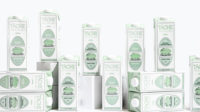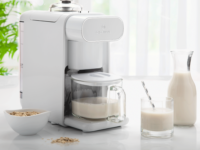Category Focus
Digesting the future for dairy, alternative milks
Total milk looks to stabilize volume declines

Image courtesy of Getty Images
Airing on Fox from 2002 to 2016, “American Idol” was a ratings juggernaut for the TV network but began experience viewership declines, resulting in Fox eventually canceling the show in 2016. The show then made a comeback when rival network ABC purchased the rights revived the series, which was renewed in May for its seventh season with ABC, 22nd overall.
Total milk ― comprised of dairy, plant and all other milks ― is in hopes of its own revival as the category continues to be challenged following its spikes in volume and dollar sales in 2020.
In all, total milk is up 1.6% in dollars and down 3.2% in volume, notes John Crawford, senior vice president of client insights of dairy with Chicago-based Circana. Price per volume for total milk saw an increase of 5%, he adds.
“When you break it down between dairy and plant milk, dairy is down 1% in dollars and plant milk is up 4.3% in dollars,” Crawford explains. “Both are pretty small comparatively speaking to some other categories. For volume, dairy milk is down 2.9% and plant milk is down 6.7%. Price per volume, dairy milk is up 4% and plant is up 12%. So you start to get the story here a little bit.”

John Rodwan, editorial director at Beverage Marketing Corporation (BMC), Wintersville, Ohio, also calls attention to disparity between dollars and volume.
“Milk volume declined again in 2022 with volume dipping below 5 billion gallons,” he says. “Per capita consumption slipped to less than 15 gallons. Retail sales grew, but this was more reflective of high prices than anything else. All the major beverage categories saw sales growth last year, even those, like milk and fruit beverages, that declined in volume.”
Rodwan adds that, following several years of volume growth, dairy alternatives saw their volumes decline. “While oat milk continued to enjoy strong growth, all other segments ― including the biggest one, almond milk ― declined, resulting in an overall reduction in volume of almost 3%,” he says. “Dairy alternatives remained a fraction of the size of the traditional liquid dairy beverage market with just over 500 million gallons.”
Circana’s Crawford notes that this performance could be tied to the fact plant milks took on price increases after the rest of total milk.
“As dairy milk was coming up, they were closing that gap with dairy milk and then they couldn’t hold on much longer so when commodity costs and input costs starting going up they started to take pricing,” he says. “Now they’re pricing faster than dairy milks.”
As Rodwan and Crawford have noted, inflation has impacted the beverage industry and dairy milk and plant milks are no exception. Yet, Crawford notes we might be in the midst of an easing in terms of price increases.
“It’s starting to look a little more like 2019 where volume growth is small and dollar growth is softening,” he explains. “It’s starting to look a little more ― I don’t like to say a new normal because everybody’s been asking what the new normal looks like and I coined the phrase new abnormal because you never know what’s going to be next. But I will say, 2023 and going into 2024 it’s starting to look a little more similar to what we saw pre-pandemic.”
Pockets of growth
Although the total milk market is experiencing challenges in terms of dollars and volume performance, experts note that not all segments are struggling.
Noting dairy milks 2.9% volume decline, Circana’s Crawford identified claims that are doing well for the segment.
“The pockets of growth are lactose free, which is up 15.7% in dollars and 6.3% in volume, … high protein claims up 13.8% and 3.9% dollars and volume, respectively,” he says. “… Ultra-pasteurized, think ultra-filtered, but ultra-pasteurization leads to longer shelf life and all that kind of good stuff, but ultra-pasteurized as a claim is up 11.8% in dollars and 2.8% in volume so you’re starting to see these pockets of growth. Digestion claims, pre and probiotic claims in particular, prebiotic and probiotic claims are up significantly in dollars and volume for dairy milk.”

BMC’s Rodwan adds that, despite its small size compared with white milk, flavored milk has done well. “In the not-too-distant past, plain whole milk had been outperforming reduced-fat and fat-free milk, but more recently all the major types of white milk have been declining,” he says. “Flavored milk still accounts for a small share of total milk volume but has tended to grow.”
Despite the growth of plant-based milks in the past, the sub-segments performing well has been limited this year.
“Until recently, almond milk had been a solid grower, and a few years ago its dairy alternative market share approached 80%,” Rodwan says. “However, its volume and share declined in the last couple of years. Soy continued its long-term losing streak in 2022. Other, smaller segments have also been in decline. The one exception was oat milk, which registered another year of strong growth last year and gained market share.”
Circana’s Crawford notes that oat surpassed soy a few years ago as the No. 2 plant milk. In terms of dollar sales, it is up 14.5% while volume increased 2.1%. However, it also saw prices increase 12.1%. The other sub-segment doing well within plant milks is coconut milk, which saw dollar sales up 24.2% and volume up 6.3%. Prices also increased 16.8%.
In terms of claims, much like dairy milk, Crawford notes that plant milks do not have all the same characteristics, but still has seen some mimicking trends.
“When you go over to plant milk you don’t quite have all the same characteristics here,” he says. “It certainly is up similarly with these claims but it’s more up in dollars driven by pricing, so lactose free is up 10%, but down 1% in volume, for protein it’s up 18.2% and is basically flat in volume, ultra-pasteurized 13.4%, 4.3%, and then pre and probiotic are up significantly for both so that’s kind of the one that’s winning across both plant and dairy milk.”
In terms of the other milks comprising the total milk market, kefir experienced good growth, Crawford says. “It’s small, but it’s up 19% in dollars, it’s up 9% in volume, it’s up 9.5% in price,” he says. “So 9% in volume growth is the highest growth we’re seeing across any of these and that 19% growth in dollars is certainly significant.”
As the market reflects a challenging year, there are areas of success within total milk.
“I’d say the growth is you’ve got growth in oat milk, you’ve got growth in coconut milk, you’ve got growth in kefir those are kind of the three segments you’re seeing volume and dollar growth,” Crawford says. “And then the pockets of growth that I gave you for lactose free, protein, ultra-pasteurized, pre and probiotic.”
Opportunities to expand reach
As manufacturers contend with a challenging year, experts still anticipate declines on the horizon.
“Barring the emergence of a new segment, flavor or style that generates lately-absent enthusiasm, continued small declines look likely for dairy alternatives ― and continued declines in conventional milk appear inevitable,” BMC’s Rodwan says.

Noting that he’s no Nostradamus, Circana’s Crawford expects that volume declines should start to ease as consumers become normalized with the pricing of products.
“I would start to think we’re going to see very small growth in dollars and probably small declines in volume,” he explains. “You’re probably going to see that in both dairy and plant milk, probably into 2024 I think.
“There’s a lot of focus on normalizing all these price increases that everybody took and consumers are going to start to get used to these new price points and the new promotion price points,” he continues. “As that eases, I think volume will start to come back but again, I think we’re talking 1% decline volume and 1% growth in dollars we’re probably in that range would be my guess.”
Despite anticipated declines, research shows that milk manufacturers still have options to showcase new ways to embrace dairy and plant milks.

“Consumers are familiar with the versatility of milk, yet there is still potential to expand on its possibilities,” states Chicago-based Mintel in its September 2023 report titled “Milk and Non-Dairy Milk – US.” “From incorporating milk into a face mask to using oat milk in savory recipes, showcasing new applications can alleviate concerns about shelf life, higher prices while encouraging exploration of new milk-based experiences.”
The market research firm also notes that dairy and non-dairy milk can be positioned as a specialty drink or even targeted to specific demographic groups.
“Target parents with milks containing nutrients for development, reach athletes with formulations for performance and portable packaging, and support at-home baristas with non-dairy milks capable of frothing,” it states.
Looking for a reprint of this article?
From high-res PDFs to custom plaques, order your copy today!







